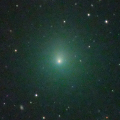
|
It brightened rapidly. Now it is very bright as 8.3 mag (Oct. 9, Michael Mattiazzo). It stays observable at 8 mag in excellent condition from October to November.
Date(TT) R.A. (2000) Decl. Delta r Elong. m1 Best Time(A, h)
Oct. 10 4 42.19 -28 35.2 0.484 1.289 116 8.6 3:27 ( 0, 26)
Oct. 17 4 55.81 -24 35.0 0.446 1.275 119 8.3 3:13 ( 0, 30)
|
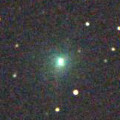
|
Now it is very bright as 10.0 mag (Oct. 2, Michael Mattiazzo). Although it is a tiny comet, it will approach to Sun down to 0.34 a.u. on Oct. 20, and brighten up to 8.5 mag. However, it is not observable now. In the Northern Hemisphere, it will appear in the morning sky at 10 mag in late October. Then it stasy observable while the comet will be fading rapidly. In the Southern Hemipshere, it will never be observable again.
Date(TT) R.A. (2000) Decl. Delta r Elong. m1 Best Time(A, h)
Oct. 10 12 33.45 -26 55.1 0.667 0.450 21 9.6 4:38 (288,-23)
Oct. 17 12 41.74 -9 32.9 0.683 0.355 11 8.7 4:43 (276, -9)
|
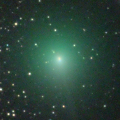
|
Now it is 9.1 mag (Oct. 3, Marco Goiato). It stays bright as 8-9 mag until early November. It will be observable in excellent condition in the Southern Hemisphere. It locates very low in the Northern Hemisphere.
Date(TT) R.A. (2000) Decl. Delta r Elong. m1 Best Time(A, h)
Oct. 10 17 21.36 -26 55.3 1.448 1.361 64 8.8 18:55 ( 39, 16)
Oct. 17 17 49.05 -27 16.4 1.480 1.372 63 8.8 18:46 ( 37, 17)
|
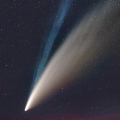
|
It approached to Sun down to 0.29 a.u. on July 3, and it brightened up to 0.6 mag (Alan Hale). Now it is fading. It has already faded down to 11.3 mag (Sept. 27, Mitsunori Tsumura). It will be unobservable soon. Then it will appear in the morning sky at 14 mag.
Date(TT) R.A. (2000) Decl. Delta r Elong. m1 Best Time(A, h)
Oct. 10 15 14.70 -14 1.3 2.847 2.087 33 11.5 18:55 ( 69, 4)
Oct. 17 15 22.14 -15 12.5 3.019 2.195 28 11.8 18:46 ( 70, 1)
|

|
Now it is 11.2 mag (Sept. 11, Carlos Labordena). It will be unobservable soon. Then it will appear in the morning sky at 13.5 mag.
Date(TT) R.A. (2000) Decl. Delta r Elong. m1 Best Time(A, h)
Oct. 10 15 6.29 -10 2.9 3.401 2.595 30 12.0 18:55 ( 74, 5)
Oct. 17 15 15.74 -11 55.8 3.514 2.660 26 12.2 18:46 ( 74, 2)
|
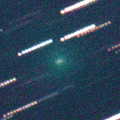
|
Now it is very bright as 12.5 mag (Oct. 8, Michael Jager). It will approach to Sun down to 0.4 a.u. on Dec. 13, and it is expected to brighten up to 6.5 mag. It stays observable while the comet is brightening until late November when it brightens up to 7-8 mag.
Date(TT) R.A. (2000) Decl. Delta r Elong. m1 Best Time(A, h)
Oct. 10 8 47.80 2 53.0 1.599 1.471 64 12.7 4:38 (298, 38)
Oct. 17 9 14.40 0 2.4 1.450 1.349 63 12.1 4:43 (302, 38)
|
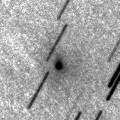
|
Brightened rapidly. Now it is very bright as 12.8 mag (Oct. 6, Taras Prystavski). It is observable at 12-13 mag in excellent condition from October to November.
Date(TT) R.A. (2000) Decl. Delta r Elong. m1 Best Time(A, h)
Oct. 10 23 38.78 -29 45.5 0.494 1.407 138 13.4 22:20 ( 0, 26)
Oct. 17 23 33.97 -25 40.1 0.484 1.384 135 12.9 21:48 ( 0, 30)
|

|
It brightened up to 13.5 mag in summer (July 31, Ken-ichi Kadota). Now it is not observable. It is expected to brighten up to 12 mag from autumn to winter. In the Southern Hemisphere, it will appear in the morning sky in December, then it stays observable in good condition. In the Northern Hemisphere, it will be observable in the extremely low sky only from November to December.
Date(TT) R.A. (2000) Decl. Delta r Elong. m1 Best Time(A, h)
Oct. 10 13 6.60 5 27.4 2.804 1.839 12 13.1 18:55 (104,-10)
Oct. 17 13 13.13 2 4.7 2.771 1.807 11 13.0 4:43 (261, -8)
|
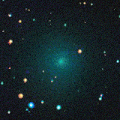
|
Now it is 12.5-13.0 mag (Sept. 19, Michael Jager). It is very bright as 11.3 mag visually (Sept. 12, Carlos Labordena). It stays observable in excellent condition in the Northern Hemipshere. It becomes observable in low sky from October to November also in the Southern Hemipshere.
Date(TT) R.A. (2000) Decl. Delta r Elong. m1 Best Time(A, h)
Oct. 10 20 26.15 43 42.7 0.897 1.551 109 13.2 19:07 (180, 82)
Oct. 17 20 3.89 33 51.0 1.061 1.605 102 13.7 18:46 ( 77, 84)
|
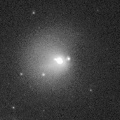
|
Now it is 14.1 mag (Sept. 22, S. Shurpakov).
Date(TT) R.A. (2000) Decl. Delta r Elong. m1 Best Time(A, h)
Oct. 10 2 45.07 27 31.4 4.959 5.829 147 13.2 1:31 ( 0, 83)
Oct. 17 2 42.01 27 25.1 4.913 5.831 154 13.2 1:00 ( 0, 83)
|
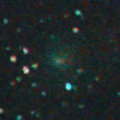
|
It brightened up to 14.2 mag in August (Aug. 18, Alan Hale). It approached to Sun down to 0.47 a.u. in September, and it was expected to brighten up to 11 mag. But actually, it was fainter than predicted. It is not observable after this.
Date(TT) R.A. (2000) Decl. Delta r Elong. m1 Best Time(A, h)
Oct. 10 11 57.03 -5 40.1 1.674 0.768 16 14.0 4:38 (274, -4)
Oct. 17 12 23.12 -6 19.7 1.801 0.890 16 14.8 4:43 (276, -3)
|
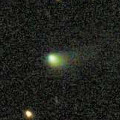
|
Now it is 15.3 mag (Sept. 12, SONEAR Observatory, Oliveira). It stays 13-14 mag from 2020 to 2021. It is not observable until January.
Date(TT) R.A. (2000) Decl. Delta r Elong. m1 Best Time(A, h)
Oct. 10 14 32.42 -7 45.9 3.855 2.956 22 14.4 18:55 ( 81, 0)
Oct. 17 14 42.81 -8 56.6 3.876 2.947 18 14.4 18:46 ( 81, -3)
|
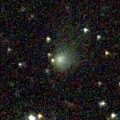
|
Now it is 15.0 mag (Sept. 20, Hiroshi Abe). It is expected to be observable at 5-6 mag for a long time from 2022 to 2023. In the Northern Hemisphere, it is not observable at the high light from 2022 summer to 2023 summer. In the Southern Hemisphere, it is only visible in the extremely low sky in summer in 2020. But it will be observable in good condition at the high light.
Date(TT) R.A. (2000) Decl. Delta r Elong. m1 Best Time(A, h)
Oct. 10 17 9.07 41 30.4 8.293 8.074 73 14.7 18:55 (114, 54)
Oct. 17 17 11.39 40 38.7 8.281 8.021 71 14.6 18:46 (113, 51)
|
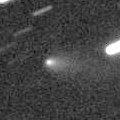
|
First return of a new periodic comet which brightened up to 13 mag in 2009. Now it is 15.9 mag (Sept. 21, Michael Jager). It is expected to brighten up to 12 mag and to be observable in excellent condition in winter.
Date(TT) R.A. (2000) Decl. Delta r Elong. m1 Best Time(A, h)
Oct. 10 3 49.32 -6 20.3 0.685 1.567 136 15.1 2:34 ( 0, 49)
Oct. 17 3 57.10 -7 53.0 0.628 1.528 139 14.7 2:15 ( 0, 47)
|
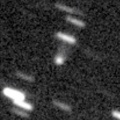
|
Now it is 16.1 mag (Sept. 3, Blue Mountains Observatory, Leura). It will brighten up to 13 mag in 2021. In the Southern Hemisphere, it stays observable at 15 mag until October. In the Northern Hemisphere, it is not observable until July in 2022.
Date(TT) R.A. (2000) Decl. Delta r Elong. m1 Best Time(A, h)
Oct. 10 14 34.51 -32 32.1 5.058 4.263 33 14.8 18:55 ( 60,-14)
Oct. 17 14 41.41 -33 32.8 5.068 4.230 29 14.8 18:46 ( 60,-17)
|
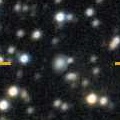
|
Now it is 15 mag (Sept. 11, Giuseppe Pappa). It will brighten up to 12 mag in winter in 2022. In the Northern Hemisphere, it stays observable in good condition for a long time. In the Southern Hemisphere, it is not observable until 2021 November.
Date(TT) R.A. (2000) Decl. Delta r Elong. m1 Best Time(A, h)
Oct. 10 0 20.56 65 48.9 4.772 5.347 120 14.9 23:02 (180, 59)
Oct. 17 0 14.16 65 36.4 4.706 5.304 122 14.8 22:28 (180, 59)
|

|
Now it is 14.3 mag (Sept. 29, Thomas Lehmann). It stays 14 mag until autumn. In the Southern Hemisphere, it will never be observable again.
Date(TT) R.A. (2000) Decl. Delta r Elong. m1 Best Time(A, h)
Oct. 10 14 44.33 66 33.2 4.572 4.428 75 14.9 18:55 (151, 35)
Oct. 17 14 55.07 65 13.8 4.604 4.472 76 14.9 18:46 (150, 34)
|
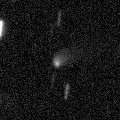
|
Now it is 15.1 mag (Sept. 15, Blue Mountains Observatory, Leura). It stays 14-15 mag until 2021. In the Southern Hemisphere, it stays observable in good condition for a long time. In the Northern Hemisphere, it is not observable until June in 2021.
Date(TT) R.A. (2000) Decl. Delta r Elong. m1 Best Time(A, h)
Oct. 10 17 38.77 -70 37.0 4.656 4.536 76 15.2 18:55 ( 12,-19)
Oct. 17 17 56.36 -69 32.6 4.701 4.519 73 15.2 18:46 ( 13,-18)
|

|
Now it is 15.4 mag (Sept. 21, Slooh.com Chile Observatory, La Dehesa). It will brighten up to 13.5 mag in spring in 2021. In the Southern Hemisphere, it stays observable in good condition for a long time. In the Northern Hemisphere, it is not observable until spring in 2021.
Date(TT) R.A. (2000) Decl. Delta r Elong. m1 Best Time(A, h)
Oct. 10 17 14.50 -52 14.4 4.044 3.794 68 15.3 18:55 ( 25, -5)
Oct. 17 17 13.76 -50 55.1 4.127 3.764 62 15.3 18:46 ( 29, -6)
|
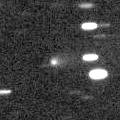
|
Now it is 15.5 mag (Sept. 19, M. Jaeger, E. Prosperi, S. Prosperi). It stays 15.5 mag until winter, and observable in good condition. It locates somewhat low in the Southern Hemisphere.
Date(TT) R.A. (2000) Decl. Delta r Elong. m1 Best Time(A, h)
Oct. 10 8 0.23 18 8.5 2.032 2.077 78 15.3 4:38 (293, 57)
Oct. 17 8 10.15 17 53.6 1.986 2.111 82 15.4 4:43 (300, 61)
|
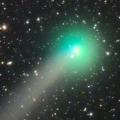
|
It brightened up to 6.0 mag in June (June 13, Marco Goiato). Now it is fading. It has already faded down to 14.5 mag (Oct. 4, Michael Jager). It stays observable in good condition for a long time after this.
Date(TT) R.A. (2000) Decl. Delta r Elong. m1 Best Time(A, h)
Oct. 10 16 45.58 23 1.8 2.314 2.047 62 15.6 18:55 ( 89, 44)
Oct. 17 17 0.86 23 2.4 2.428 2.135 61 16.0 18:46 ( 90, 43)
|
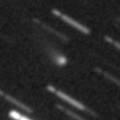
|
Now it is 15.3 mag (Sept. 9, M. Jaeger, E. Prosperi, S. Prosperi). It will stay at 14 mag for a long time from 2021 to 2022. In the Northern Hemisphere, it stays observable in good condition while brightening gradually. In the Southern Hemisphere, it stays locating low for a long time.
Date(TT) R.A. (2000) Decl. Delta r Elong. m1 Best Time(A, h)
Oct. 10 17 28.57 15 21.5 6.076 5.802 69 15.6 18:55 ( 72, 48)
Oct. 17 17 29.73 14 8.2 6.138 5.776 64 15.6 18:46 ( 74, 44)
|
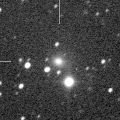
|
It brightened up to 13.5 mag in winter (Dec. 6, Chris Wyatt). Now it is fading slowly. Now it is 14.6 mag (Sept. 20, Katsumi Yoshimoto). In the Southern Hemisphere, it stays observable for a long time. It locates somewhat low in the Northern Hemisphere. Taras Prystavski found its fragmentation on Sept. 12.
Date(TT) R.A. (2000) Decl. Delta r Elong. m1 Best Time(A, h)
Oct. 10 2 26.96 -37 54.7 3.722 4.445 131 15.9 1:13 ( 0, 17)
Oct. 17 2 17.11 -37 32.8 3.757 4.484 131 16.0 0:36 ( 0, 18)
|

|
Now it is 15.3 mag (Aug. 28, Chris Wyatt). It stays 16 mag until winter. In the Southern Hemisphere, it is observable in excellent condition. It will be getting higher graually after this also in the Northern Hemisphere.
Date(TT) R.A. (2000) Decl. Delta r Elong. m1 Best Time(A, h)
Oct. 10 20 55.70 -53 48.0 0.885 1.452 100 15.9 19:39 ( 0, 2)
Oct. 17 21 4.94 -49 29.8 0.878 1.418 98 15.9 19:21 ( 0, 6)
|
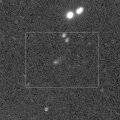
|
Now it is 15.1 mag (Sept. 22, S. Shurpakov). It will brighten up to 14.5 mag from spring to summer in 2021. In the Southern Hemisphere, it stays observable in excellent condition for a long time. In the Northern Hemisphere, it is observable in good condition in 2020, however, it will be unobservable in 2021.
Date(TT) R.A. (2000) Decl. Delta r Elong. m1 Best Time(A, h)
Oct. 10 21 33.16 -21 28.2 2.689 3.323 121 15.9 20:15 ( 0, 33)
Oct. 17 21 26.68 -23 23.4 2.766 3.281 112 15.9 19:41 ( 0, 32)
|
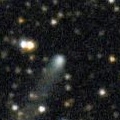
|
Now it is 15.9 mag (Sept. 20, Thomas Lehmann). It stays 15-16 mag for a long time until 2021.
Date(TT) R.A. (2000) Decl. Delta r Elong. m1 Best Time(A, h)
Oct. 10 18 25.48 19 11.8 4.574 4.572 83 15.9 18:55 ( 63, 62)
Oct. 17 18 25.05 19 3.5 4.679 4.584 78 16.0 18:46 ( 69, 58)
|
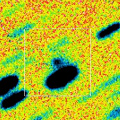
|
Now it is 17.2 mag (Aug. 17, P. Camilleri, H. Williams). It brightens up to 15 mag in winter. But it is not observable at high light. In the Southern Hemisphere, it stays observable in good condition until autumn when the comet will brighten up to 16 mag. It stays locating very low in the Northern Hemisphere.
Date(TT) R.A. (2000) Decl. Delta r Elong. m1 Best Time(A, h)
Oct. 10 18 38.48 -31 1.9 2.240 2.314 81 16.0 18:55 ( 21, 21)
Oct. 17 18 49.16 -29 53.7 2.300 2.292 77 15.9 18:46 ( 23, 21)
|

|
It was expected to brighten very rapidly, and brighten up to 14.5 mag from August to September. However, its current brightness is very uncertain. It could not be detected as fainter than 18.0 mag on June 30 (Charles S. Morris), and fainter than 15.7 mag on July 13 (Sandor Szabo). However, Giuseppe Pappa reported as 14 mag on July 10, and Thomas Lehmann reported it is bright as 15.2 mag on July 12. In the Northern Hemisphere, it stays observable for a long time. In the Southern Hemisphere, it is not observable until late October.
Date(TT) R.A. (2000) Decl. Delta r Elong. m1 Best Time(A, h)
Oct. 10 10 50.31 13 44.6 1.789 1.185 38 16.0 4:38 (267, 20)
Oct. 17 10 50.69 9 19.7 1.781 1.258 43 16.3 4:43 (276, 25)
|
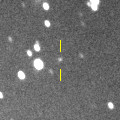
|
Now it is 15.9 mag (Apr. 24, J. Drummond). It is expected to brighten up to 13 mag in 2022. In 2020, it is observable in excellent condition in the Southern Hemisphere. In the Northern Hemisphere, it is observable from autumn to winter, but it locating extremely low.
Date(TT) R.A. (2000) Decl. Delta r Elong. m1 Best Time(A, h)
Oct. 10 8 19.43 -31 52.4 6.708 6.438 70 16.2 4:38 (328, 15)
Oct. 17 8 22.83 -32 40.9 6.609 6.399 73 16.2 4:43 (335, 17)
|

|
Now it is 15.9 mag (Sept. 16, J. Drummond). It is observable at 15-16 mag in 2020. It is observable in excellent condition in the Southern Hemisphere. It locates somewhat low in the Northern Hemisphere.
Date(TT) R.A. (2000) Decl. Delta r Elong. m1 Best Time(A, h)
Oct. 10 17 59.21 -24 32.2 7.172 6.946 72 16.3 18:55 ( 33, 23)
Oct. 17 17 59.14 -24 13.4 7.309 6.964 66 16.4 18:46 ( 37, 21)
|
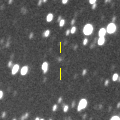
|
Now it is 16.5 mag (Sept. 11, Giuseppe Pappa). It is observable at 16.5-17 mag from 2020 to 2021. In the Southern Hemisphere, it is not observable until summer in 2021.
Date(TT) R.A. (2000) Decl. Delta r Elong. m1 Best Time(A, h)
Oct. 10 22 42.87 70 18.6 5.578 6.032 112 16.5 21:24 (180, 55)
Oct. 17 22 30.75 68 44.1 5.550 6.024 113 16.5 20:44 (180, 56)
|
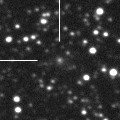
|
It brightened up to 14.6 mag in summer (July 18, Thomas Lehmann). Now it is 15.2 mag (Sept. 20, Thomas Lehmann). It stays observable until December when it becomes fainter than 18 mag.
Date(TT) R.A. (2000) Decl. Delta r Elong. m1 Best Time(A, h)
Oct. 10 19 59.50 -13 5.4 1.701 2.148 102 16.6 18:55 ( 4, 42)
Oct. 17 20 10.25 -13 25.9 1.790 2.166 97 16.8 18:46 ( 7, 41)
|

|
Now it is 18.6 mag (Aug. 6, Palomar Mountain--ZTF). It will approach to Sun down to 0.14 a.u. on Dec. 7, and will brighten up to 11 mag. But it is not observable at the high light. It is observable until November when it brightens up to 16 mag.
Date(TT) R.A. (2000) Decl. Delta r Elong. m1 Best Time(A, h)
Oct. 10 8 25.04 24 12.6 1.143 1.296 74 17.0 4:38 (278, 55)
Oct. 17 8 54.40 21 39.0 1.000 1.200 73 16.6 4:43 (282, 55)
|
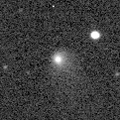
|
It brightened up to 13.8 mag in autumn in 2019 (Sept. 3, Chris Wyatt). Now it is fading slowly. Now it is 15.2 mag (Sept. 22, S. Shurpakov). In 2020, it stays observable in good condition while the comet will be fading from 16 to 17 mag.
Date(TT) R.A. (2000) Decl. Delta r Elong. m1 Best Time(A, h)
Oct. 10 0 0.03 1 52.6 5.444 6.409 163 16.7 22:42 ( 0, 57)
Oct. 17 23 56.29 1 56.2 5.528 6.451 156 16.8 22:11 ( 0, 57)
|
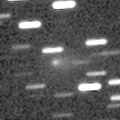
|
Now it is 15.0-15.5 mag (Sept. 19, Michael Jager). It will be fading after this, and will be fainter than 18 mag in November. It is observable in good condition in the Northern Hemisphere. It locates low in the Southern Hemisphere.
Date(TT) R.A. (2000) Decl. Delta r Elong. m1 Best Time(A, h)
Oct. 10 8 24.04 20 25.1 1.350 1.432 73 16.8 4:38 (284, 54)
Oct. 17 8 40.45 19 42.0 1.340 1.471 76 17.0 4:43 (288, 57)
|
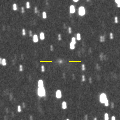
|
Now it is 16.8 mag (Sept. 20, Thomas Lehmann). It stays 16.5 mag until October, and observable in good condition.
Date(TT) R.A. (2000) Decl. Delta r Elong. m1 Best Time(A, h)
Oct. 10 20 35.15 4 6.9 1.551 2.154 113 16.8 19:18 ( 0, 59)
Oct. 17 20 43.37 2 54.2 1.619 2.161 109 16.9 18:59 ( 0, 58)
|
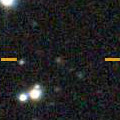
|
Now it is 17.4 mag (Sept. 18, E. Bryssinck). It will brighten up to 13.5 mag from winter to spring in 2021. In the Northern Hemisphere, it stays observable in excellent condition. In the Southern Hemisphere, it stays extremely low until 2021 spring.
Date(TT) R.A. (2000) Decl. Delta r Elong. m1 Best Time(A, h)
Oct. 10 23 55.71 50 48.5 1.707 2.503 133 17.1 22:37 (180, 74)
Oct. 17 23 46.67 50 28.8 1.631 2.429 133 16.9 22:01 (180, 74)
|
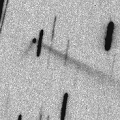
|
Now it is 17.5 mag (Aug. 15, Toshihiko Ikemura, Hirohisa Sato). Main-belt asteroid. But it showed a straight tail like a comet in 2019. In 2020, it brightens up to 16.5 mag and stays observable in good condition from September to October.
Date(TT) R.A. (2000) Decl. Delta r Elong. m1 Best Time(A, h)
Oct. 10 0 9.02 -2 26.8 1.332 2.308 163 17.0 22:51 ( 0, 53)
Oct. 17 0 4.67 -4 10.8 1.380 2.323 155 17.2 22:19 ( 0, 51)
|
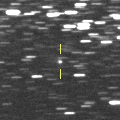
|
Now it is 16.6 mag (Sept. 19, D. Buczynski). It is observable at 16.5-17 mag from spring in 2020 to summer in 2021.
Date(TT) R.A. (2000) Decl. Delta r Elong. m1 Best Time(A, h)
Oct. 10 17 15.99 2 11.2 4.988 4.637 63 17.0 18:55 ( 61, 38)
Oct. 17 17 16.38 1 0.1 5.089 4.634 57 17.0 18:46 ( 64, 33)
|
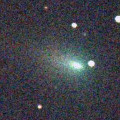
|
Recovered from SWAN images after 24-year blank. It brightened up to 10.2 mag in spring (May 31, Marco Goiato). Now it is fading very rapidly. It has already faded down to 18.0 mag (Sept. 12, M. Jaeger, E. Prosperi, S. Prosperi).
Date(TT) R.A. (2000) Decl. Delta r Elong. m1 Best Time(A, h)
Oct. 10 7 16.06 7 42.8 1.832 2.047 87 17.0 4:38 (320, 57)
Oct. 17 7 21.94 7 0.7 1.802 2.099 92 17.3 4:43 (332, 59)
|
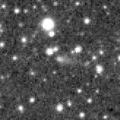
|
First return of a new periodic comet which brightened up to 17.5 mag in 2012. Now it is 17.5 mag (Aug. 15, Toshihiko Ikemura, Hirohisa Sato). It stays observable at 17 mag in good condition from summer to winter. It locates somewhat low in the Southern Hemisphere.
Date(TT) R.A. (2000) Decl. Delta r Elong. m1 Best Time(A, h)
Oct. 10 5 17.13 34 27.5 1.814 2.416 115 17.0 4:02 ( 0, 89)
Oct. 17 5 19.41 35 16.7 1.759 2.432 121 17.0 3:37 (180, 90)
|

|
It will brighten very rapidly, and will brighten up to 11 mag from December to January. It stays observable for a long time. In the Southern Hemipshere, it locates low until the high light.
Date(TT) R.A. (2000) Decl. Delta r Elong. m1 Best Time(A, h)
Oct. 10 17 37.00 -10 11.4 1.295 1.305 67 17.6 18:55 ( 46, 32)
Oct. 17 17 50.30 -10 25.0 1.270 1.231 64 17.0 18:46 ( 47, 31)
|
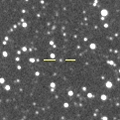
|
Now it is 16.6 mag (Sept. 19, M. Jaeger, E. Prosperi, S. Prosperi). It stays at 17 mag from 2020 to 2021.
Date(TT) R.A. (2000) Decl. Delta r Elong. m1 Best Time(A, h)
Oct. 10 18 55.52 30 25.4 8.772 8.862 91 17.1 18:55 ( 80, 73)
Oct. 17 18 55.53 30 9.8 8.842 8.858 87 17.1 18:46 ( 83, 69)
|
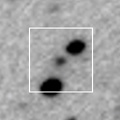
|
Now it is 17.6 mag (Sept. 21, A. Diepvens). It will approach to Earth down to 0.5 a.u. in November, and brighten up to 17 mag. It is observable in excellent condition.
Date(TT) R.A. (2000) Decl. Delta r Elong. m1 Best Time(A, h)
Oct. 10 23 31.51 29 43.0 0.536 1.483 148 17.4 22:14 ( 0, 85)
Oct. 17 23 34.54 27 48.1 0.516 1.458 147 17.2 21:49 ( 0, 83)
|
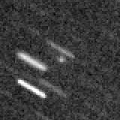
|
Now it is 18.1 mag (Sept. 20, Katsumi Yoshimoto). It will approach to Earth down to 0.46 a.u. in 2021 April, and it is expected to brighten up to 12.5 mag and to be observable in excellent condition.
Date(TT) R.A. (2000) Decl. Delta r Elong. m1 Best Time(A, h)
Oct. 10 1 15.01 -14 18.6 1.429 2.387 158 17.6 0:02 ( 0, 41)
Oct. 17 0 43.62 -17 6.2 1.380 2.305 151 17.3 22:55 ( 0, 38)
|
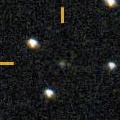
|
Now it is 17.6 mag (Sept. 20, A. Diepvens). It is observable at 17-18 mag for a long time from late 2019 to early 2021. It will fade out before it passes the perihelion.
Date(TT) R.A. (2000) Decl. Delta r Elong. m1 Best Time(A, h)
Oct. 10 6 1.51 16 28.8 4.202 4.585 106 17.5 4:38 (353, 71)
Oct. 17 6 2.44 16 31.8 4.091 4.574 113 17.5 4:20 ( 0, 72)
|

|
It brightened up to 7.7 mag in June in 2018 (June 19, Juan Jose Gonzalez). Now it is fading. It has already faded down to 18.7 mag (Sept. 20, ATLAS-MLO, Mauna Loa). In the Southern Hemisphere, it stays observable for a long time. It will be observable in good condition after this also in the Northern Hemisphere.
Date(TT) R.A. (2000) Decl. Delta r Elong. m1 Best Time(A, h)
Oct. 10 6 39.36 -12 7.6 7.660 7.796 94 17.5 4:38 (345, 42)
Oct. 17 6 38.34 -12 22.7 7.613 7.848 99 17.6 4:43 (356, 43)
|

|
It brightened up to 13.2 mag from spring to autumn in 2019 (June 30, Thomas Lehmann). Now it is fading slowly. It has already faded down to 16.2 mag (Sept. 11, Giuseppe Pappa). In the Southern Hemisphere, it stays observable for a long time. In the Northern Hemisphere, it stays low for a long time.
Date(TT) R.A. (2000) Decl. Delta r Elong. m1 Best Time(A, h)
Oct. 10 22 25.25 -27 42.9 4.141 4.830 128 17.5 21:07 ( 0, 27)
Oct. 17 22 20.53 -26 54.5 4.270 4.871 121 17.7 20:35 ( 0, 28)
|
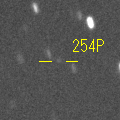
|
Now it is 17.9 mag (Sept. 23, ATLAS-MLO, Mauna Loa). It stays 17.5 mag until November. It is observable in excellent condition in the Southern Hemisphere. It locates very low in the Northern Hemisphere.
Date(TT) R.A. (2000) Decl. Delta r Elong. m1 Best Time(A, h)
Oct. 10 23 3.83 -36 15.2 2.412 3.137 128 17.6 21:46 ( 0, 19)
Oct. 17 23 2.39 -36 21.6 2.483 3.138 122 17.6 21:17 ( 0, 19)
|
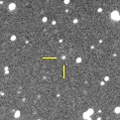
|
Now it is 17.2 mag (Sept. 13, E. Bryssinck). It was observed at 17 mag in 2019. In 2020, it is observable at 17.5 mag in good condition from summer to autumn.
Date(TT) R.A. (2000) Decl. Delta r Elong. m1 Best Time(A, h)
Oct. 10 0 36.41 -7 43.9 2.821 3.792 164 17.7 23:18 ( 0, 47)
Oct. 17 0 32.18 -7 53.2 2.858 3.800 157 17.8 22:46 ( 0, 47)
|

|
It stays observable at 17 mag for a long time until 2027. In the Southern Hemipshere, it stays observable in good condition for a long time. It is not observable in the Northern Hemipsphere.
Date(TT) R.A. (2000) Decl. Delta r Elong. m1 Best Time(A, h)
Oct. 10 10 3.80 -47 7.0 12.459 11.922 55 17.7 4:38 (322,-10)
Oct. 17 10 5.23 -47 44.9 12.411 11.904 57 17.7 4:43 (326, -6)
|
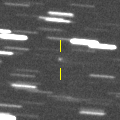
|
Now it is 17.4 mag (Sept. 5, ATLAS-MLO, Mauna Loa). It stays observable at 17.5-18 mag in good condition until winter.
Date(TT) R.A. (2000) Decl. Delta r Elong. m1 Best Time(A, h)
Oct. 10 7 17.72 17 2.5 1.786 2.019 88 17.8 4:38 (308, 64)
Oct. 17 7 27.42 17 5.0 1.732 2.041 92 17.8 4:43 (319, 67)
|
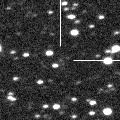
|
Now it is 17.2 mag (Sept. 12, D. Buczynski). It stays 15-16 mag for a long time from 2021 spring to 2022 spring. It stays observable for a long time in the Northern Hemisphere. In the Southern Hemipsphere, it is not observable until the end of 2021.
Date(TT) R.A. (2000) Decl. Delta r Elong. m1 Best Time(A, h)
Oct. 10 19 44.31 51 41.6 3.934 4.251 101 17.9 18:55 (165, 73)
Oct. 17 19 37.55 50 32.3 3.940 4.206 98 17.8 18:46 (152, 72)
|

|
Now it is 16.5 mag (Sept. 16, J. Drummond). In the Southern Hemisphere, it stays observable at 18 mg until winter. It is not observable in the Northern Hemisphere.
Date(TT) R.A. (2000) Decl. Delta r Elong. m1 Best Time(A, h)
Oct. 10 19 49.72 -86 45.1 4.352 4.363 84 17.9 18:55 ( 0,-32)
Oct. 17 19 17.12 -86 15.9 4.412 4.362 80 17.9 18:46 ( 1,-31)
|
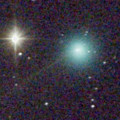
|
It passed the perihelion on June 25, and brightened up to 7.3 mag (June 30, Chris Wyatt). Now it is fading. It has already faded down to 16.9 mag (Sept. 12, J. Drummond). In the Southern Hemisphere, it stays observable in good condition in the evening sky while the comet will be fading. It locates very low in the Northern Hemisphere.
Date(TT) R.A. (2000) Decl. Delta r Elong. m1 Best Time(A, h)
Oct. 10 18 10.68 -29 35.8 1.853 1.873 75 17.9 18:55 ( 28, 19)
Oct. 17 18 26.60 -28 58.8 2.011 1.951 72 18.4 18:46 ( 28, 20)
|

|
New comet discovered in the images of SOHO spacecraft. It approached to Sun down to 0.09 a.u. on Aug. 8, and it brightened up to 3 mag. It will appear in the morning sky in October. But it must be fainter than 18 mag.
Date(TT) R.A. (2000) Decl. Delta r Elong. m1 Best Time(A, h)
Oct. 10 10 56.13 -2 36.1 2.424 1.659 31 18.1 4:38 (280, 10)
Oct. 17 11 3.21 -3 30.9 2.487 1.786 36 18.5 4:43 (285, 15)
|
|
![]()
 84P/Giclas
84P/Giclas C/2019 U6 ( Lemmon )
C/2019 U6 ( Lemmon ) C/2018 U1 ( Lemmon )
C/2018 U1 ( Lemmon ) C/2018 F4 ( PanSTARRS )
C/2018 F4 ( PanSTARRS ) 162P/Siding Spring
162P/Siding Spring C/2019 T2 ( Lemmon )
C/2019 T2 ( Lemmon ) C/2019 K7 ( Smith )
C/2019 K7 ( Smith ) 17P/Holmes
17P/Holmes C/2020 H4 ( Leonard )
C/2020 H4 ( Leonard ) C/2019 T4 ( ATLAS )
C/2019 T4 ( ATLAS ) C/2017 U7 ( PanSTARRS )
C/2017 U7 ( PanSTARRS ) C/2019 T3 ( ATLAS )
C/2019 T3 ( ATLAS ) 115P/Maury
115P/Maury (3200) Phaethon
(3200) Phaethon C/2017 B3 ( LINEAR )
C/2017 B3 ( LINEAR ) 304P/Ory
304P/Ory 257P/Catalina
257P/Catalina C/2020 N1 ( PanSTARRS )
C/2020 N1 ( PanSTARRS ) (6478) Gault
(6478) Gault C/2017 Y2 ( PanSTARRS )
C/2017 Y2 ( PanSTARRS ) 58P/Jackson-Neujmin
58P/Jackson-Neujmin P/2020 M2 ( Lemmon )
P/2020 M2 ( Lemmon ) 141P/Machholz 2
141P/Machholz 2 C/2019 O3 ( Palomar )
C/2019 O3 ( Palomar ) 11P/Tempel-Swift-LINEAR
11P/Tempel-Swift-LINEAR C/2020 R4 ( ATLAS )
C/2020 R4 ( ATLAS ) 173P/Mueller 5
173P/Mueller 5 C/2016 M1 ( PanSTARRS )
C/2016 M1 ( PanSTARRS ) C/2018 A6 ( Gibbs )
C/2018 A6 ( Gibbs ) 254P/McNaught
254P/McNaught 215P/NEAT
215P/NEAT C/2019 E3 ( ATLAS )
C/2019 E3 ( ATLAS ) 178P/Hug-Bell
178P/Hug-Bell C/2020 M5 ( ATLAS )
C/2020 M5 ( ATLAS ) C/2019 NJ3 ( Lemmon )
C/2019 NJ3 ( Lemmon ) 2P/Encke
2P/Encke C/2020 P4 ( SOHO )
C/2020 P4 ( SOHO )![]()















































